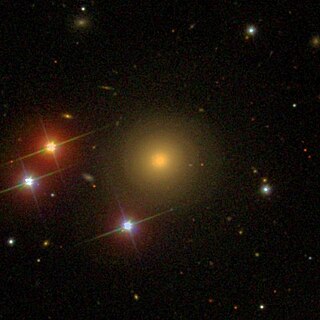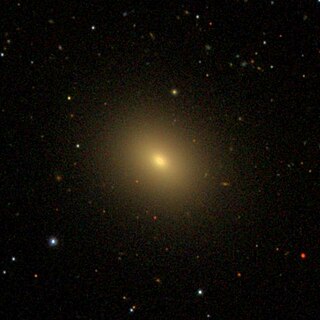
NGC 584 is an elliptical galaxy in the constellation Cetus. The galaxy was discovered on 10 September 1785 by the German-British astronomer William Herschel.

NGC 98 is a barred spiral galaxy in the Phoenix constellation. The galaxy NGC 98 was discovered on September 6, 1834 by the British astronomer John Frederick William Herschel.

NGC 99 is a spiral galaxy in the constellation Pisces. It was discovered on 8 October 1883 by the French astronomer Édouard Stephan.

NGC 81 is a lenticular galaxy estimated to be about 270 million light-years away in the constellation of Andromeda.

NGC 83 is an elliptical galaxy estimated to be about 260 million light-years away in the constellation of Andromeda. It was discovered by John Herschel in 1828 and its apparent magnitude is 14.2.

NGC 86 is a lenticular galaxy estimated to be between 275 and 300 million light-years away in the constellation of Andromeda. It was discovered by Guillaume Bigourdan in 1884 and its apparent magnitude is 14.9.

NGC 96 is a lenticular galaxy estimated to be about 290 million light-years away in the constellation of Andromeda. It was discovered by Guillaume Bigourdan in 1884 and its apparent magnitude is 17.

NGC 97 is an elliptical galaxy estimated to be about 230 million light-years away in the constellation of Andromeda. It was discovered by John Herschel in 1828 and its apparent magnitude is 13.5.

NGC102 is a lenticular galaxy estimated to be about 330 million light-years away in the constellation of Cetus. It was discovered by Francis Leavenworth in 1886 and its apparent magnitude is 14.

NGC 94 is a lenticular galaxy in the constellation Andromeda. It was discovered by Guillaume Bigourdan in 1884. This object is extremely faint and small. A little above the galaxy is NGC 96. NGC 94 is about 260 million light-years away and 50,000 light-years across.

NGC 124 is a spiral galaxy in the constellation Cetus. It was discovered by Truman Henry Safford on September 23, 1867. The galaxy was described as "very faint, large, diffuse, 2 faint stars to northwest" by John Louis Emil Dreyer, the compiler of the New General Catalogue.

NGC 5343 is an elliptical galaxy in the constellation of Virgo. It was discovered on 5 May 1785 by William Herschel.

NGC 154 is an elliptical galaxy in the Cetus constellation. The galaxy was discovered by Frederick William Herschel on November 27, 1785.

NGC 155 is a lenticular galaxy in the Cetus constellation. It was discovered on September 1, 1886, by Lewis A. Swift.

NGC 159 is a barred lenticular galaxy in the constellation Phoenix. The galaxy was discovered on October 28, 1834, by John Frederick William Herschel.

NGC 161 is a lenticular galaxy in the Cetus constellation. It was discovered on November 21, 1886, by Lewis A. Swift.

NGC 163 is an elliptical galaxy in the constellation Cetus. It was discovered by William Herschel in 1890. Seen through an optical telescope it ranges up to 13th magnitude.

NGC 252 is a lenticular galaxy located in the constellation Andromeda. It was discovered by William Herschel in 1786.

NGC 257 is a spiral galaxy in the Pisces constellation. It was discovered on December 29, 1790, by Frederick William Herschel.

NGC 834 is a spiral galaxy located in the Andromeda constellation. It is estimated to be 160 million light-years away from the Milky Way galaxy and has a diameter of about 65,000 light-years. The object was discovered on September 21, 1786 by the astronomer William Herschel.




















